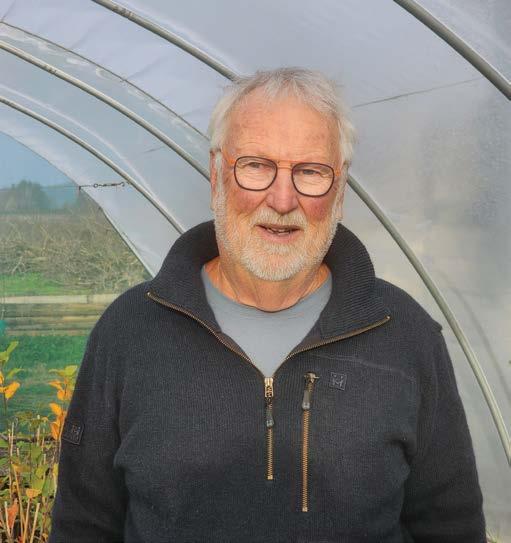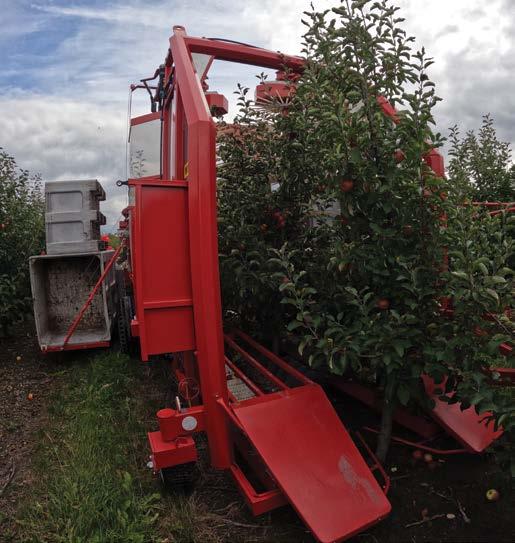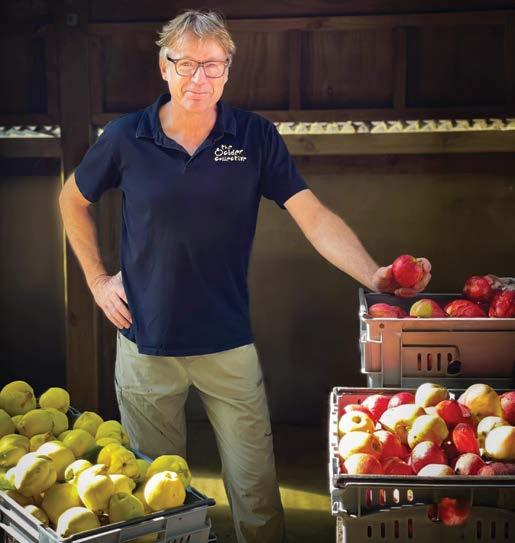
7 minute read
SPECIALIST APPLES ATTRACT NEW CAPITAL
Almost a year ago, the roadmap for a $1 billion premium cider industry with over 2000ha of cider orchards featured in NZGrower & Orchardist. Since then Cider Apples NZ co-founders Allan White and John Powell report that investment is picking up. JOHN GAULDIE sat down with Havelock North-based Allan to get a taste of the developing premium cider industry.
Is the roadmap attracting enough capital to get specialist cider apple growing off the ground?
The initial government funding was great in enabling two guys who had no resources to start something. So that’s a positive example of the way in which government investment can enable things to happen. But it was funding from both government and industry, with support from the Ministry for Primary Industries Sustainable Food and Fibre Futures fund, AGMARDT, Fruit Wine & Cider Makers Association NZ, Prevar, Plant & Food Research and Cider Apples NZ. Good progress has been made since the release of the report. Morning Cider in Auckland has embraced the roadmap and just completed a $500,000 capital raise to help fund development of premium cider export sales.
That’s all on the back of ciders that come from the varieties that have been talked about in the roadmap.
We’ve got four other companies that are similarly looking to expand their production up to around about a million litres, which is what we think they need to have to sustain an export industry. So that’s five existing cideries. So it’s happening.

At Cider Apples NZ we did some capital raising, which wasn’t too painful. We also managed to get Callaghan Innovation grant funding, which is very generous. A major expansion of the Accelerated Cider Apple Breeding Programme from 4000 trees to 12,000 trees is underway and will be completed by September 2026.
Why is new cider apple variety development so important?
Traditional cider apples are usually varieties developed over 100 years ago in Northern Europe, when the climate was significantly cooler than it is today. They suffer from low productivity, poor climate resilience, poor resistance to disease and pests, and a flavour profile that can be challenging in many of the markets that have the potential to drive global growth.
Premiumisation in the cider industry will be driven by new varieties of cider apples that produce exciting new styles of cider, with unique flavour profiles, and more global consumer appeal that cannot be easily replicated in other countries.
Cider Apples NZ has identified five new cider apple varieties through screening apples from Prevar, Plant & Food Research and other breeding programmes.
We’ve got to get enough production though, that’s the thing. We are seeking interest from growers and cider makers in the first three of these varieties.
What is the economic case for growing premium cider apples given strong demand for premium eating apples?
I know cider makers who are paying $0.60/kg for orchard run Braeburn. But we’ve talked with people in Europe and other countries and there is quite a premium paid for specialist cider apples as opposed to reject eating apples. In the United States cider makers are paying over US$1 per pound for the specialist cider apples (approx. NZ$3.75/kg). So we set the price in our economic evaluation on the conservative side of $1/kg. And we also picked the yield at 80 tonnes per hectare, which is again conservative. So it’s pretty compelling.
The limitation is always going to be on getting people making and exporting cider to buy into the game. But it seems to be happening. They’ve got to look at how they guarantee supply of these apples. So that will hopefully translate into contracts being offered to growers.
And we’ve got growers now who are wanting to invest in planting – there’s one in the Horowhenua. So it’s starting to build momentum from within the existing cider industry.
The roadmap identified China as a key export market for premium cider. How confident are you that this market will develop?
Cider is not consumed a lot at this stage in Asia, but it is growing. We know the market prefers a high quality dry cider. We have some key importers in China who have invested in New Zealand’s cider industry and they are pretty excited about the prospects of cider in China.
We are setting up a consumer behaviour trial in China later this year with the small scale precommercial ciders made from this year’s crop of a range of new cider apples. That should help us to build up a detailed understanding of Chinese consumer preferences for different elements of a premium priced cider. That information will feed back into cider apple selection criteria for the Cider Apples NZ breeding programme. It should give us a lot of confidence around the sort of prospects that we would have in China.
We find the best way of convincing people about the opportunity is to give them some premium cider to drink. And then all rational discussion goes out the window. It’s exactly the same as with my experience with premium apples. You give somebody an Envy™ apple and they immediately get what it’s all about.

How does growing a cider apple differ from growing an eating apple?
We think that the approach to growing cider apples is very similar to growing fresh apples except that there are reasons not to go into the elaborate 2D type trellis systems. One of them is mechanical harvesting, which is economically a no-brainer. Fresh fruit growers say, “Look at all the damage to the fruit,” but if you’re going to be processing it within a few days, then it’s not an issue. And when it comes to thinning and pruning as well as harvesting, the opportunity for mechanisation of all those activities is brilliant.
There’s less risk – you’re not so worried about skin finish problems like from hail damage. Some of the varieties that we’re proposing will have a high level of tolerance. So there’s the opportunity to reduce your inputs.
Some of these cider apple varieties grow well in marginal areas that are not current centres for fresh fruit production, like Horowhenua or Wairarapa. One of the disincentives for developing fresh fruit in those regions is the lack of the infrastructure that’s required, like cool storage, but that’s not such an issue for cider.
But processing is a consideration that needs to be looked at. Fresh apple juice, like fresh grape juice, has a very short shelf life. It has to be processed within six or eight hours. So apart from the existing cideries and the big apple juice processing plants, like Profruit and Cedenco, we see an opportunity for winemakers to diversify.

It has been suggested that the Fruit Wine & Cider Makers Association NZ expands into apple growing with a commodity levy. What is the best set-up for industry good leadership for cider apple growers?
Right from the beginning, we’ve talked with grower industry good bodies and you know, the short answer is processing fruit is not part of their mandate.
It’s something that John and I have not wanted to get dragged into too much, the debate around how an industry infrastructure should be developed. John and I are a private company. We’re not the industry. We’re breeding the apples, we’re identifying apples that will make high quality ciders.
But when you start digging into it, cider relies on the systems that have been set up by the fresh fruit industry. There are things like spray diaries, for example. And cider makers rely on assurance programmes developed for fresh fruit. The issues range right through from production, varieties, markets, infrastructure to excise tax.
I think there is a value in having industry bodies, certainly from a lobbying point of view and from an identity point of view. So it is a discussion that needs to be had.
For more about cider and to download the Premium Cider Industry Roadmap Report, visit: ciderapplesnz.com










